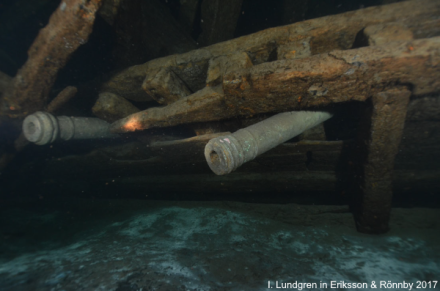History
Discovery
In May 2011, the Mars was discovered by Richard Lundgren and his team from Ocean Discovery off the island of Öland after many years of systematic side-scan surveying. Since the discovery, archaeological fieldwork has been carried out in cooperation with the Maritime Archaeological Research Institute (MARIS) at Södertörn University, Stockholm.
History
This Swedish warship was larger than any contemporary ship and was therefore referred to as 'Makalös' (matchless). It was the largest carvel built warship of the Royal Swedish Navy under King Erik XIV at a time when carvel construction was still a novelty in the Baltic Sea.
The Swedish monarch's attempt to achieve hegemony over the Baltic Sea by launching a series of large warships did not go unnoticed, resulting in the Nordic Seven Years’ War (1563-1570), in which his growing power was challenged by the Kingdom of Denmark and the Hanseatic City of Lübeck. One year after the outbreak - in spring 1564 - a naval battle occurred between the Swedish and the allied Danish-Lübeckian fleet, lasting for two days. Initially the Swedish fleet under the command of admiral Jacob Bagge gained the upper hand, partly due to the heavy artillery on board of Mars. In the course of the battle, however, the fleet formation was not maintained due to bad weather and visibility and the ships dispersed. After disengaging during nighttime, Mars found itself surrounded by enemy vessels the next morning, and was attacked with incedendiary ammunition at close range by Lübeckian ships under the command of admiral Friedrich Knevel, which set Mars ablaze. The vessel struck its flag and was boarded by 300 Lübeckers, but in the meantime the fire had reached the powder magazine and a massive explosion led to the loss of the ship and all on board.
The impact of the explosion on Mars's hull integrity is strikingly visible as in a time-capsule. The entire wreck site - which is also a battle site - was visualised by a photomosaic, which reflects the inconceivable violence of the loss.
Part of a documentary on the Mars by National Geographic.
Description
| People on board | 700 |
|---|---|
| Length | 315 ½ feet (96.2 m) |
| Beam | 44 ¼ feet (13.5 m) |
| Tonnage | 700 ton (350 last) |
| Displacement | 1800 ton (900 last) |
Status
Due to the great depth of 75 metres, the wreck is particularly well-preserved from both biological decay and anthropogenic impact. Maritime archaeological research campaigns are still ongoing, requiring remote operable vehicles (ROV) and technical divers.
There is also a contemporary report by the admiral of the Lübeck fleet - Friedrich Knevel - of the sinking of Mars in the Lübeck archive (ASA Externa Suecica 123), which has recently become the subject of a research project. Thus, a wealth of additional knowledge can be expected from this wreck and its historical context.

References
- Anderson, R. C. (1939).
The Mars and the Adler.
The Mariner’s Mirror 25.3.
pp 296–299. - Ekman, C. (1939).
The Swedish Ship Mars or Makalös.
The Mariner’s Mirror 25.1.
pp 5–10. - Eriksson, N. (2012).
Skeppet Mars—en ny bekantskap!.
Marinarkeologisk Tidskrift 2.
pp 10–13. - Eriksson, N. (2016).
The architecture of a great 16th-century warship: results from the initial surveys of Mars (1564).
Actas del V Congreso Internacional de Arqueología Subacuatica (IKUWA 5), Cartagena, 2014.
pp 824–836. - Eriksson, N. & Rönnby, J. (2017).
Mars (1564): the initial archaeological investigations of a great 16th-century Swedish warship.
The International Journal of Nautical Archaeology 46.1.
pp 92-107. - Glete, J. (2010).
Swedish Naval Administration, 1521–1721. Resource Flows and Organisational Capabilities.
Leiden/Bosten: Brill. - Dr. Dagmar Hemmie & Dr. Jan Lokers (Archive of the Hanseatic City of Lübeck).
Document "ASA Externa Suecica 123".